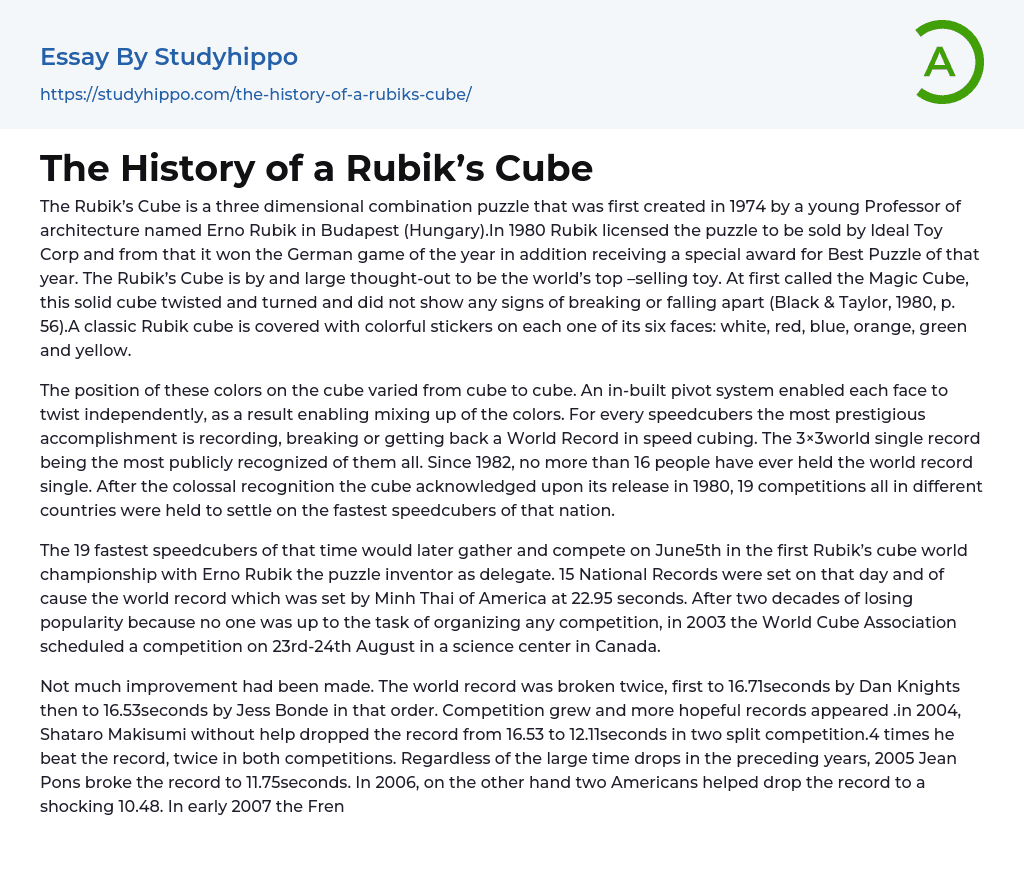The Rubik’s Cube is a three dimensional combination puzzle that was first created in 1974 by a young Professor of architecture named Erno Rubik in Budapest (Hungary).In 1980 Rubik licensed the puzzle to be sold by Ideal Toy Corp and from that it won the German game of the year in addition receiving a special award for Best Puzzle of that year. The Rubik’s Cube is by and large thought-out to be the world’s top –selling toy. At first called the Magic Cube, this solid cube twisted and turned and did not show any signs of breaking or falling apart (Black & Taylor, 1980, p. 56).A classic Rubik cube is covered with colorful stickers on each one of its six faces: white, red, blue, orange, green and yellow.
The position of these colors on the cube varied from cube to cube. An in-built pivot sy
...stem enabled each face to twist independently, as a result enabling mixing up of the colors. For every speedcubers the most prestigious accomplishment is recording, breaking or getting back a World Record in speed cubing. The 3×3world single record being the most publicly recognized of them all. Since 1982, no more than 16 people have ever held the world record single. After the colossal recognition the cube acknowledged upon its release in 1980, 19 competitions all in different countries were held to settle on the fastest speedcubers of that nation.
The 19 fastest speedcubers of that time would later gather and compete on June5th in the first Rubik’s cube world championship with Erno Rubik the puzzle inventor as delegate. National Records were set on that day and of cause the world record whic
was set by Minh Thai of America at 22.95 seconds. After two decades of losing popularity because no one was up to the task of organizing any competition, in 2003 the World Cube Association scheduled a competition on 23rd-24th August in a science center in Canada.
Not much improvement had been made. The world record was broken twice, first to 16.71seconds by Dan Knights then to 16.53seconds by Jess Bonde in that order. Competition grew and more hopeful records appeared .in 2004, Shataro Makisumi without help dropped the record from 16.53 to 12.11seconds in two split competition.4 times he beat the record, twice in both competitions. Regardless of the large time drops in the preceding years, 2005 Jean Pons broke the record to 11.75seconds. In 2006, on the other hand two Americans helped drop the record to a shocking 10.48. In early 2007 the French reclaimed their record with 10.36 seconds single. At the Spanish Open in 2007 Thibaut Jacquinot was the man to hold the first under ten seconds record, he set the new World Record as 9.86seconds.This record was however broken twice in the same year 2007 first by Erik AKKersdijk with a 9.77,followed by Ron Van Bruchem with a 9.55 record. It appeared that shortly after the 10 second barrier was broken new time records came flooding in.
Edouvard Chambon claimed the record back with a 9.18 in February 2008. In May 2008 Yu Nakajima made history, not only did he break the 9 seconds barrier with 8.72 seconds but he also solved the Rubik’s Cube solution in the specific time at the closing of the matching competition. Just 3 months after sub-9 barrier,
Erik AKKersdijk nearly broke the sub-7 barrier by solving in 7.08seconds.Considered monumental this record stood for 854 days. Nonetheless in 2010, Feliks zemdeg came in solving the Rubik’s Cube in 7.03 seconds. On the same day, he broke the 7 seconds barrier by solving the cube in 6.8 seconds. All through the 2011 duration, he broke the record 4 times, to 6.65, 6.24, 6.18 and finally 5.66. After two years a Dutchman Mats Valk knocked 0.11 seconds off the record solving the cube in 5.55seconds. This new record stood for two years until 2015 in April where American Collins Burns solved the cube in5.25 seconds.
November 21st 2015 was considered the greatest day in speed cubing history. After 7 months Collin Burns beat his own record by solving the cube in 5.21 seconds and excitement escalated from the speed solving forum. This was however, not long because rumors from River hall in Maryland indicated that Keaton Ellis had solved the cube in 5.09seconds. The win in this competition however, came with Lucas Etter who broke the record and set the current world record, having solved the cube in 4.90 seconds (Singmaster, 1981, p. 69). The Greek architect Panagiotis Verdes patented a means of creating cubes past the 5×5×5, up to 11×11×11, in 2003. Starting June 19, 2008, the 5×5×5, 6×6×6, and 7×7×7 models were in creation in his "V-Cube" line. V-Cube was also responsible for the production of the 2×2×2, 3×3×3 and 4x4x4. (Taylor & Rylands, (1981, p. 77).
Rubik cubes solutions are fun to play for children and even adults; it is a good way to keep the brain motivated and sharp when it comes to
solving solutions. Parents should encourage their children to play with the Rubik cubes instead of wasting their time video gaming. This is a fun activity that can be enjoyed by all members of the family and thus bringing the family together.
Works Cited
- Black, M. R., & Taylor, H. (1980). Unscrambling the Cube. . Burbank: Zephyr Engineering Design press.
- Singmaster, D. (1981). Notes on Rubik's Magic Cube. Newyork: Penguin Books press.
- Taylor, D., & Rylands, L. ((1981). Cube Games: 92 Puzzles & Solutions. New York: Holt, Rinehart and Winston press.




